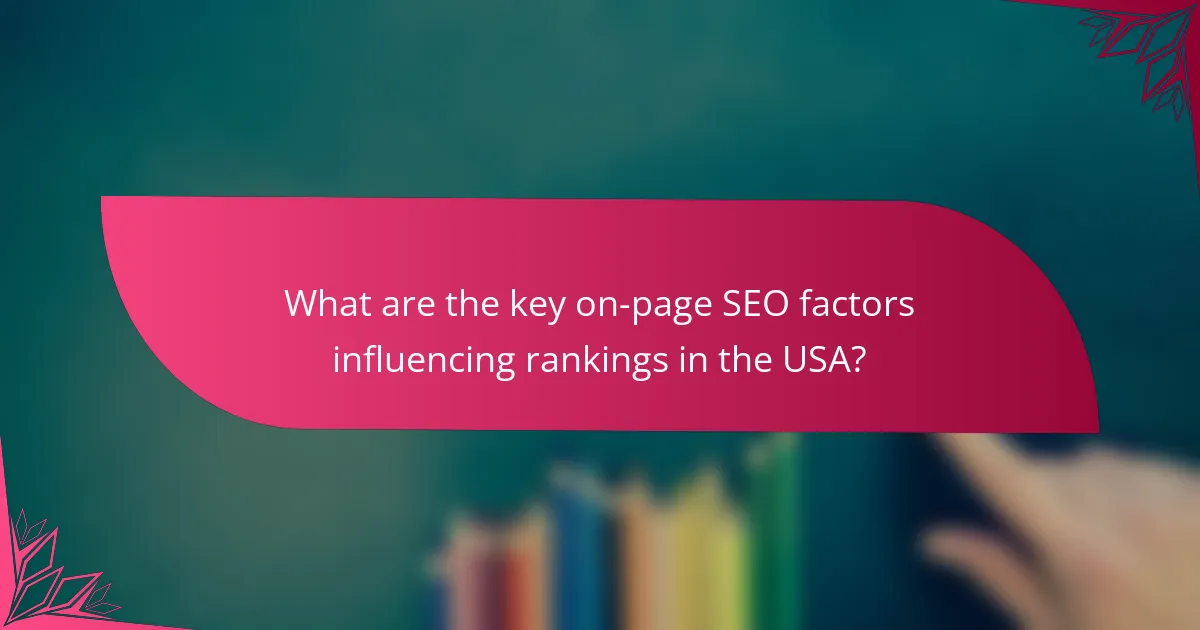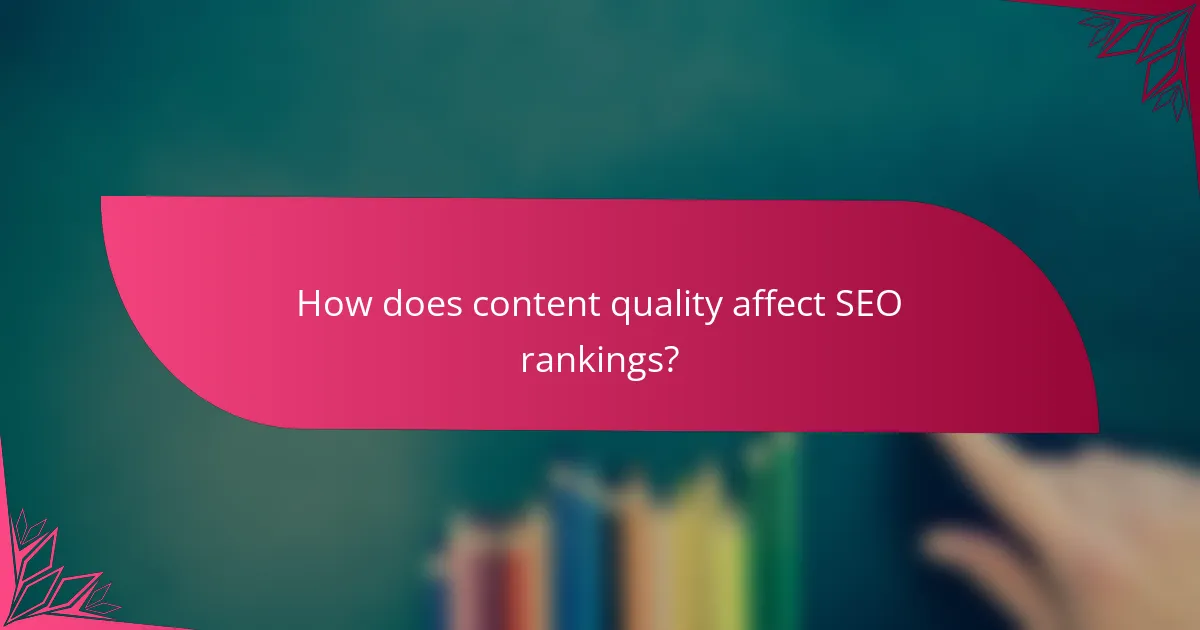On-page SEO factors are critical for improving website rankings in the USA, with key elements including content quality, keyword optimization, meta tags, internal linking, and page load speed. High-quality content not only engages users but also enhances visibility in search results, while effective keyword usage helps search engines accurately interpret webpage content. Understanding and optimizing these factors can significantly impact a site’s performance in search engine rankings.

What are the key on-page SEO factors influencing rankings in the USA?
The key on-page SEO factors that influence rankings in the USA include content quality, keyword optimization, meta tags, internal linking, and page load speed. Each of these elements plays a crucial role in determining how well a webpage performs in search engine results.
Content quality and relevance
High-quality content that is relevant to the target audience is essential for effective on-page SEO. This means providing valuable information that addresses user intent and answers their questions. Content should be well-researched, engaging, and updated regularly to maintain its relevance.
To enhance content quality, focus on creating comprehensive articles that cover topics in depth. Use headings and bullet points to improve readability, and include images or videos to enrich the user experience. Aim for content that is at least 1,000 words, as longer articles often perform better in search rankings.
Keyword optimization
Keyword optimization involves strategically placing relevant keywords throughout your content to improve visibility in search results. Identify primary and secondary keywords that align with user searches and incorporate them naturally into headings, subheadings, and body text.
Avoid keyword stuffing, as it can lead to penalties from search engines. Instead, focus on variations and related terms to create a more natural flow. Tools like Google Keyword Planner can help identify popular search terms in the USA, guiding your optimization efforts.
Meta tags and descriptions
Meta tags, including title tags and meta descriptions, are crucial for on-page SEO as they provide search engines with information about your content. A well-crafted title tag should be concise, include primary keywords, and accurately reflect the content of the page.
Meta descriptions should summarize the page’s content in a compelling way, encouraging users to click through from search results. Aim for around 150-160 characters for meta descriptions to ensure they display fully in search results.
Internal linking structure
An effective internal linking structure helps search engines understand the hierarchy and relationship between pages on your site. Use descriptive anchor text for links to guide users and search engines to relevant content within your website.
Ensure that important pages are easily accessible through internal links, ideally within a few clicks from the homepage. This not only improves SEO but also enhances user navigation, keeping visitors engaged longer.
Page load speed
Page load speed is a critical factor in user experience and SEO rankings. Websites that load quickly tend to have lower bounce rates and higher engagement. Aim for a load time of under three seconds to maintain user interest.
To improve page speed, optimize images, minimize HTTP requests, and leverage browser caching. Tools like Google PageSpeed Insights can help identify specific areas for improvement, ensuring your site performs well in the competitive online landscape.

How does content quality affect SEO rankings?
Content quality significantly influences SEO rankings by affecting how users interact with a website. High-quality content attracts more visitors, keeps them engaged, and encourages them to share, all of which can boost search engine visibility.
Engagement metrics
Engagement metrics, such as bounce rate, time on page, and click-through rate, are critical indicators of content quality. When users spend more time on a page and interact with the content, search engines interpret this as a sign of relevance and value.
To improve engagement, focus on creating compelling headlines, using visuals, and structuring content for easy readability. Aim for a bounce rate below 50% and a time on page of at least a few minutes to signal quality to search engines.
Originality and depth
Originality and depth are essential for establishing authority and trustworthiness in your content. Search engines favor unique, in-depth articles that provide comprehensive insights over generic or shallow content.
To enhance originality, conduct thorough research and present unique perspectives or solutions. Aim for content that is at least 1,000 words long, as longer articles often perform better in search rankings due to their depth and detail.

What role do keywords play in on-page SEO?
Keywords are essential for on-page SEO as they help search engines understand the content of a webpage. Properly using keywords can significantly influence rankings in search results, making it easier for users to find relevant information.
Keyword placement
Keyword placement refers to the strategic positioning of keywords within a webpage’s content. Important areas for keyword inclusion include the title tag, headers, and the first 100 words of the body text. This helps search engines identify the main topic of the page.
Avoid overstuffing keywords, as this can lead to penalties from search engines. Instead, aim for a natural flow of language that incorporates keywords seamlessly into the content. A good rule of thumb is to use the primary keyword once in the title, once in a header, and a few times throughout the body.
Long-tail keywords
Long-tail keywords are more specific phrases that typically consist of three or more words. They tend to have lower search volume but higher conversion rates, as they target users who are further along in the buying process. For instance, instead of just “shoes,” a long-tail keyword would be “best running shoes for flat feet.”
Incorporating long-tail keywords can improve your chances of ranking for niche queries. Focus on user intent and consider common questions or phrases that potential customers might use. This approach can enhance relevance and drive more qualified traffic to your site.

How important are meta tags for SEO?
Meta tags are crucial for SEO as they provide search engines with essential information about a webpage’s content. They influence how pages are displayed in search results, impacting click-through rates and overall visibility.
Title tags
Title tags are one of the most significant on-page SEO elements. They appear as the clickable headline in search engine results and should ideally be between 50 to 60 characters long. A well-crafted title tag includes relevant keywords and accurately reflects the page’s content to attract users.
To optimize title tags, place the primary keyword at the beginning and keep the wording clear and compelling. Avoid keyword stuffing, as this can lead to penalties from search engines. For example, instead of “Best SEO Services SEO Company,” use “Top SEO Services for Small Businesses.”
Meta descriptions
Meta descriptions summarize a webpage’s content and appear below the title tag in search results. Although they don’t directly influence rankings, a compelling meta description can significantly improve click-through rates. Aim for about 150 to 160 characters to ensure the entire description is visible.
When writing meta descriptions, include relevant keywords and a clear call to action. For instance, “Discover affordable SEO services that boost your online presence. Contact us today!” This approach encourages users to click through to your site. Avoid duplicating meta descriptions across multiple pages to maintain uniqueness and relevance.

What is the impact of internal linking on SEO?
Internal linking significantly enhances SEO by improving site navigation and distributing page authority. This practice helps search engines understand the structure of a website and the relationship between its pages, which can positively influence rankings.
Improved navigation
Internal links facilitate better navigation for users, allowing them to easily find related content. By strategically placing links within your site, you can guide visitors to important pages, reducing bounce rates and increasing the time spent on your site.
For example, if you have a blog post about “On-Page SEO,” linking to related articles on keyword research or technical SEO can help users explore more of your content. Aim for a logical flow that enhances user experience.
Page authority distribution
Internal linking helps distribute page authority across your website, which can boost the rankings of lower-authority pages. When a high-authority page links to another page, it passes some of its authority, helping the linked page gain visibility in search results.
To optimize this, ensure that your most valuable content is easily accessible through internal links. A good practice is to link to important pages from your homepage or other high-traffic areas, allowing them to benefit from increased authority.

How does page load speed influence SEO rankings?
Page load speed significantly impacts SEO rankings in the USA by affecting user engagement and satisfaction. Faster loading times lead to lower bounce rates and higher conversions, which search engines like Google consider when ranking pages.
User experience
User experience is directly tied to page load speed, as slow-loading pages frustrate visitors. A delay of just a few seconds can lead to increased bounce rates, meaning users leave before engaging with the content. Aim for load times under three seconds to enhance user satisfaction.
To improve user experience, consider optimizing images, leveraging browser caching, and minimizing HTTP requests. Tools like Google PageSpeed Insights can help identify specific areas for improvement.
Mobile optimization
Mobile optimization is crucial since a significant portion of web traffic comes from mobile devices. Pages that load quickly on smartphones and tablets not only improve user experience but also rank better in mobile search results. Ensure your site is responsive and loads efficiently on various screen sizes.
Implement techniques like responsive design, AMP (Accelerated Mobile Pages), and mobile-friendly testing to enhance load speed on mobile devices. Regularly check your site’s performance on mobile to maintain optimal speeds and user engagement.
